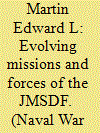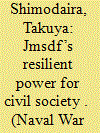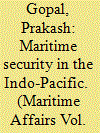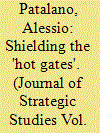| Srl | Item |
| 1 |
ID:
009193


|
|
|
|
|
| Publication |
Spring 1995.
|
| Description |
39-67
|
|
|
|
|
|
|
|
|
|
|
|
|
|
|
|
| 2 |
ID:
146364


|
|
|
|
|
| Summary/Abstract |
The Asia-Pacific is a disaster-prone region. In humanitarian assistance and disaster relief (HA/DR) operations, it is crucial to save lives at the outset. Success in the initial phase will produce trustful relationships among civil and military actors and will influence subsequent relief operations. Soon after Typhoon Haiyan (Yolanda) struck the central Philippines on 8 November 2013, the United States dispatched an aircraft carrier and conducted Operation DAMAYAN.
|
|
|
|
|
|
|
|
|
|
|
|
|
|
|
|
| 3 |
ID:
154574


|
|
|
|
|
| Summary/Abstract |
The strategic construct of the Indo-Pacific has today gained salience due to the region becoming the centre of gravity of economic development and social mobility. This has been driven, to a large extent, by commercial maritime activity and the assurance of security on the global commons. The US has played a significant role in the provision of this security, with Japan and Australia emerging as vital regional partners in this effort. While the US' presence in the region was primarily motivated by its Cold War aim of containing communism, the post-Cold War period has demanded a fresh approach to maritime security in the Indo-Pacific. Transforming geo-political and strategic considerations have, however, raised questions on the continued efficacy of this system. With the somewhat problematic rise of China, the US, Japan, Australia and India, as major regional maritime powers, need to evolve a regional maritime security architecture that will continue to support the peaceful and legitimate use of the seas.
|
|
|
|
|
|
|
|
|
|
|
|
|
|
|
|
| 4 |
ID:
085098


|
|
|
|
|
| Publication |
2008.
|
| Summary/Abstract |
The build-up of Japan's military apparatus in the 1990s and 2000s has been often regarded by security analysts as indicative of a departure from the country's Cold War strategic posture. Japan appears to be engaged in a process of militarisation that is eroding the foundations of its 'exclusively defence-oriented' policy. In the case of the archipelago's naval strategy, such assessments overlook the longstanding significance of a core feature of its defence policy, namely the surveillance of maritime crossroads delivering the wealth of the country. The paper reassesses the evolution of the Japanese strategy since the Cold War by examining the development of the Japanese Maritime Self-Defence Force's submarine force, one of the key components of the defensive shield for these crossroads. The paper argues that with the changes in the security environment of the 1990s, Japan already fielded a mature force with state-of-the-art submarines, and that the rise of a new naval competitor aiming at controlling key strategic points along Japan's sea lanes reconfirmed the critical importance of submarine operations to Japanese national security
|
|
|
|
|
|
|
|
|
|
|
|
|
|
|
|